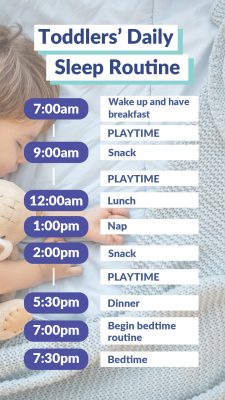
Just when you get a handle on a sleep routine for your baby, they turn into toddlers. And everyone knows that toddlers tend to have very strong opinions about all sorts of things — especially bedtime. To help tired parents everywhere, we asked the experts for their tips on getting toddlers to sleep and put together a sample toddler sleep schedule for parents making the shift.
How Much Sleep Do Toddlers Need?
There’s a lot of growth and development happening in the first few years of a child’s life, and sleep is key. “Toddlers typically need 10 to 12 hours of sleep in a 24-hour period,” says Dr. Patricia Bertz, a board-certified pediatrician at Renown Health in Reno, Nevada. But that number fluctuates. “It varies depending on when they’re going through a growth spurt.” That means some toddlers could be sleeping up to 14 hours in a 24-hour window.
While parents definitely need the down time, sleep plays a direct role in your toddler’s health. “Sleep is essential for physical growth, cognitive growth and organ functioning, and immune function,” says Bertz. Sleep is also how your toddler recharges his or her batteries. “It is very apparent when toddlers are tired, because they will have fewer coping mechanisms — they’ll get frustrated more easily, cry more, won’t calm down or de-escalate their emotions as well, and throw tantrums.”
It’s not just behavioral issues, either. “Memory, attention, emotional regulation, and learning are all affected by sleep,” says Dr. Steven Abelowitz, MD FAAP and Regional Medical Director of Coastal Kids Pediatrics. “Insufficient sleep can lead to growth delays, developmental deficiencies, and behavior challenges.”
Do Toddlers Need Sleep During the Day?
Absolutely — and not just because parents need a break. Time spent snoozing throughout the day counts toward a toddler’s total daily sleep. It gives little minds and bodies a chance to rest and recharge. Plus, research suggests that daytime napping for young children is critical for early memory development and self-regulation, or their ability to control their own behavior, attention, and emotions.
A good rule of thumb is a daily nap for one to two hours, says Bertz, but “there is the outlier child who takes multiple ten-minute naps throughout the day.” Your family’s schedule will also play a role here. If you have an early start, your toddler may benefit from shorter naps in the morning and afternoon.
How to Create a Toddler Sleep Schedule
Toddlers do well with structure and routine, and that’s particularly true come bedtime. “Bedtime routines help children feel comfortable and secure as they transition to sleeping,” says Dr. Bertz. That can make for easier bedtimes for toddlers and parents alike.
At night after dinner, a calming bedtime routine might look something like this:
- Give your toddler a warm bath
- Brush your toddler’s teeth
- Have your toddler use the toilet or put on a fresh diaper
- Let your toddler choose a book or two
- Sing a lullaby or say a prayer
- Give your toddler a small drink of water
- Turn on a nightlight/lullaby device
- Tuck your toddler in and say goodnight
What works for one toddler may not work for another, so be prepared to spend a little time figuring out your routine. “It could be a bath, sitting on a parent’s lap to read a story, singing a song, saying a prayer, a massage,” says Bertz.
The idea is to choose calming activities that will help relax your toddler, not wind them up, and meet all their needs so they aren’t calling you back because they’re thirsty or need their favorite stuffed bear. Still, “some children are so energetic they just have to calm themselves to sleep,” says Bertz. “They just jump or roll around in their crib until they run out of steam and fall asleep.” If that sounds like your little one, she advises keeping the household quiet and less stimulating after your little one’s bedtime so your toddler doesn’t feel like they’re missing out.
Whatever routine works for you and your toddler, be consistent. “Keeping to a regular time for bed is very helpful,” says Bertz. “I find that many parents pick the bedtime, but it can be earlier than they think.” Bedtimes tend to be most successful when the bedtime routine begins before a toddler becomes overtired. “When children are overtired, they can get that ‘second wind’ of energy or become more fussy and difficult to put down to sleep.”
In other words, don’t skip nap time in the hopes that it will make bedtime easier. That will likely backfire spectacularly.
Sample Toddler Sleep Schedule
Every child is different, but it can be helpful to get an idea of a possible sleep schedule for toddlers. Remember, toddlers typically need a total of 10 to 12 hours of sleep in a 24-hour period, including one or two naps for one to two hours. With that in mind, a toddler sleep schedule might look something like this:

- 7 a.m. – wake up and have breakfast
- Playtime
- 9 a.m. – snack
- Playtime
- 12 p.m. – lunch
- 1 p.m. – nap
- 2-3 p.m. – snack
- Playtime
- 5:30-6 p.m. – dinner
- 7 p.m. – begin bedtime routine
- 7:30 p.m. – bedtime
Your family’s schedule may mean an earlier or later wake-up time, which could mean another nap in the morning or an earlier or later bedtime. A reliable sign that your toddler isn’t getting enough sleep is behavior — are they routinely getting cranky and irritable well before nap time? In that case, an earlier bedtime or an extra nap may be helpful.
Tips for Getting a Toddler to Sleep
Entire books have been written on this very topic, but these are all options worth exploring:
- Involve your toddler in the bedtime process. Let them choose their pajamas, a bedtime story, say a prayer, or turn on their night light. You might also consider creating a bedtime chart — your toddler can cross off each step as they complete it. Involving your toddler in these ways helps them feel in control.
- Create a calming environment. Just like adults respond well to a soothing sleep environment, so do toddlers. Keep the lights dim and consider playing soothing bedtime music. Keep the room cool, but comfortable. A good sleep temperature for babies and toddlers is between 68 and 72 degrees Fahrenheit if they’re dressed in light pajamas.
- Minimize distractions outside your toddler’s room. This will keep your toddler from feeling like all of the action is outside their room. If older siblings or parents are still up, make a point of keeping things quiet.
- Pick a bedtime and stick to it. That means allowing enough time to complete the other steps in your toddler’s bedtime routine. “Parents find that when their children have a structured sleep schedule, they’re much easier to manage,” says Bertz. Plus, well-rested kids are often happy kids — and that means happy parents.
- Build in activities and playtime throughout the day. Playtime is a big part of your toddler’s development and plays a role in cognitive, social, emotional, and physical growth. Giving your toddler ample time to play, both indoors and out, sets them up for easier nap times and bedtimes. They’ll need it!
- Avoid skipping naps in hopes of tiring out your toddler for bedtime. Skipping naps can be unavoidable at times, but do your best to make them a priority. Think of them as a daily reset — your active toddler needs this down time to recharge. Plus, well-timed naps really will make bedtime easier because you aren’t dealing with an overtired, cranky toddler.
Navigating Specific Sleep Challenges
Navigating bedtime can be especially difficult if your toddler is scared of sleeping alone or making the transition from a crib or out of your room into their own. Do your best to figure out the real issue. “It’s important to try to understand your toddler’s fear,” says Abelowitz. “Give the child a chance to tell you what makes him or her scared at bedtime but do not force the child to talk about the fear if he or she is not ready.”
Keep in mind that something that seems silly to you is very real to your toddler, so don’t dismiss their fears. Instead, try these tips:
- Offer vocal reassurance. Tell your toddler that you’re nearby and will be if they need anything.
- Give your toddler a security object, such as a blanket, stuffed animal, or toy they can keep next to them throughout the night.
- Plug in a nightlight in your toddler’s room. “A nightlight may be helpful for providing security at night even if the toddler is not afraid of the dark,” says Abelowitz. Just make sure it’s a true night light and not so bright that it interferes with your toddler’s ability to fall and stay asleep.
Both pediatricians also note that parents should avoid exposing their toddler to scary or violent commercials, television shows, video games, or books, all of which can increase fears at bedtime. “Their minds have a very difficult time processing these images,” says Bertz.
Last Word from Sleepopolis
A little structure can go a long way in helping your toddler get the sleep they need to thrive. Instead of letting a toddler fall into random nap and bedtimes, creating a sleep schedule will ensure adequate sleep and wake times. And here’s the bottom line — a well-rested toddler means everyone sleeps better.



























